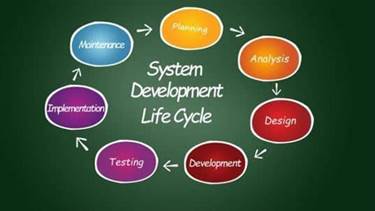Content
David Hoffman, the man who directed the film and shaped all that cloud imagery, was a General Magic employee. Cloud sandbox—A live, isolated computer environment in which a program, code or file can run without affecting the application in which it runs. Computer bureau—A service bureau providing computer services, particularly from the 1960s to 1980s.

Your organization might also use cloud-powered customer relationship management software, which makes it easy to personalize communications with customers, manage leads, and fine-tune marketing efforts across departments. Or, it might use cloud-powered solutions for human resources, payroll, accounting, and logistics. In these and countless other business use cases, cloud computing can facilitate enhanced security and streamlined data entry, not to mention time-saving automation. “The cloud” is a metaphor for a collection of shared resources, software and information. Cloud computing providers maintain networks of physical and virtual servers that contain the software and services to be provided.
It estimates that almost two-thirds of spending on application software will be via cloud computing, up from 57.7% in 2022. The main types of cloud computing services include Infrastructure-as-a-Service , Platforms-as-a-Service , and Software-as-a-Service . Cloud computing is far more than just accessing files on multiple devices. Thanks to cloud computing services, users can check their email on any computer and even store files using services such as Dropbox and Google Drive. For example, serverless, or event-driven, computing is a cloud service that executes specific functions, such as image processing and database updates.
Hpe Greenlake Cloud Services
The history and evolution of cloud computing date back to the 1950s and 1960s. DR. Cloud offers faster recovery than traditional on-premises DR. Furthermore, it is offered at lower costs. Users can be more productive because they can access work presentations and spreadsheets stored in the cloud at anytime from anywhere on any device. Companies can freely scale up as computing needs increase and scale down again as demands decrease. This eliminates the need for massive investments in local infrastructure, which might or might not remain active. Capabilities can be elastically provisioned and released, in some cases automatically, to scale rapidly outward and inward commensurate with demand.
- Though cost-savings drove much of the initial shift to the cloud, many organizations find that public, private, or a hybrid cloud infrastructure offers a host of benefits.
- But a private cloud can also be hosted on an independent cloud provider’s infrastructure or built on rented infrastructure housed in an offsite data center.
- The term ‘cloud computing’ also refers to the technology that makes cloud work.
- To the consumer, the capabilities available for provisioning often appear unlimited and can be appropriated in any quantity at any time.
- “E-commerce, software services and applications, large and small database hosting, gaming, data warehousing and internet of things are just a few of the things that people are doing in the cloud,” said Goldstein.
- The specialized model of hybrid cloud, which is built atop heterogeneous hardware, is called “Cross-platform Hybrid Cloud”.
Today, cloud computing resources can be provisioned instantly over the Internet, with the ability to scale up and down easily as needed. Companies then pay only for the resources they use, as they use them, typically on a monthly basis, without the need to worry about capacity management, hardware refreshes, or other maintenance and management tasks. For example, some applications that are critical to a business may not have been originally built for the cloud.
Types Of Cloud Computing Deployment Models
Services can be both public and private—public services are provided online for a fee while private services are hosted on a network to specific clients. In the 1970s, cloud computing began taking a more tangible shape with the introduction of the first VMs, enabling users to run more than one computing system within a single physical setup. The functionality of these VMs led to the concept of virtualization, which had a major influence on the progress of cloud computing.
Organizations are using the public cloud to host live production workloads. This requires careful design and architecture of cloud resources and services needed to create an adequate operational environment for the workload and its required level of resilience. Pay-as-you-go subscription plans for cloud use, along with scaling resources to accommodate fluctuating workload demands, can make it tough to define and predict final costs. Cloud costs are also frequently interdependent, with one cloud service often utilizing one or more other cloud services — all of which appear in the recurring monthly bill.

This gives you high performance, reliability, and uptime, no matter how you’re using the cloud. It requires a larger upfront cost and ongoing management, but it can deliver potential cost savings over the long term. A private cloud offers support for mission-critical workloads and legacy applications that are difficult or impossible to move to the public cloud. It’s also an ideal model for helping ensure compliance with privacy regulations or protecting intellectual property.
What Is Cloud Computing? Definition, Types & Benefits
When an organization deploys a public cloud model, all hardware, software, and supporting infrastructure is owned and managed by a service provider, which is delivered exclusively over the Internet. You access these services and manage your account through a web browser. Cloud computing has arrived, and everyone is interested in learning more.
This effort suggests more competition between these vendors and third-party solution providers, along with cloud provider intentions to address ease of use of their overall value proposition. These so-called hyperscalers have distributed their infrastructure across thousands of physical servers and millions of virtual machines so can be more agile in scaling service up and down with demand. However, their dominance could create risks from cloud outages, their role in critical infrastructure and public concern about their influence. Public cloud is increasingly the primary architecture for modern workloads and public cloud end-user spendingis surging. But, cost mistakesoften accompany cloud migration and ongoing cloud costs can spiral. The unique properties of cloud infrastructures provide several novel technical and business benefits.
The virtual private cloud mixes public and private offerings—a VPC user has exclusive access to an isolated segment of a public cloud. This model is a compromise between a private and public model in terms of price and features. Most businesses rely on a variety of Software as a Service products for their everyday operations. Licenses are purchased on a subscription basis and services are delivered immediately.
They began to use the cloud symbol to denote the demarcation point between what the provider was responsible for and what users were responsible for. Cloud computing extended this boundary to cover all servers as well as the network infrastructure. As computers became more diffused, scientists and technologists explored ways to make large-scale computing power available to more users through time-sharing. They experimented with algorithms to optimize the infrastructure, platform, and applications, to prioritize tasks to be executed by CPUs, and to increase efficiency for end users. In simple terms, cloud computing allows you to rent instead of buy your IT.
Multicloud is the use of two or more clouds from two or more different cloud providers. Having a multicloud environment can be as simple using email SaaS from one vendor and image editing SaaS from another. But when enterprises talk about multicloud, they’re typically talking about using multiple cloud services—including SaaS, PaaS, and IaaS services—from two or more of the leading public cloud providers.
What Is Cloud Security?
According to a recent survey, 92% of organizations use cloud today, and most of them plan to use it more within the next year. Some have gone further, effectively detatching some of those datacenters from their main business to make it much harder for US authorities – and others – to demand access to the customer data stored there. The customer data in the data centres is under the control of an independent company, which acts as a “data trustee”, and US parents cannot access data at the sites without the permission of customers or the data trustee. Expect to see cloud vendors opening more data centres around the world to cater to customers with requirements to keep data in specific locations. Analysts argue that as the cloud now underpins most new technological disruptions in everything from mobile banking to healthcare, usage is only going grow.

In July 2010, Rackspace Hosting and NASA jointly launched an open-source cloud-software initiative known as OpenStack. The OpenStack project intended to help organizations offering cloud-computing services running on standard hardware. The early code came from NASA’s Nebula platform as well as from Rackspace’s Cloud Files platform. As an open-source offering and along with other open-source solutions such as CloudStack, Ganeti, and OpenNebula, it has attracted attention by several key communities. Several studies aim at comparing these open source offerings based on a set of criteria. The App Engine was a PaaS which provided fully maintained infrastructure and a deployment platform for users to create web applications using common languages/technologies such as Python, Node.js and PHP.
A third of those surveyed cited high fees for passing data between systems as a challenge in moving their mission-critical applications. The skills required for migration are both difficult and expensive to find – and even when organisations could find the right people, they risked them being stolen away by cloud-computing vendors with deep pockets. Moving to a cloud-hosted application for services like email or CRM could remove a burden on internal IT staff, and if such applications don’t generate much competitive advantage, there will be little other impact. Moving to a services model also moves spending from capital expenditure to operational expenditure , which may be useful for some companies.
Saas Software As A Service
Today, there are several examples of cloud computing applications used by both businesses and individuals. One type of cloud service would be streaming platforms for audio or video, where the actual media files are stored remotely. Another would be data storage platforms like Google Drive, Dropbox, OneDrive, or Box. Private clouds are reserved for specific clientele, usually one business or organization. Many private cloud computing services are provided on a private network.
The same principle applies to any online service (sending an email, editing an online file, streaming a movie, listening to music, looking at social media pictures, etc.). Branch https://globalcloudteam.com/ office edge protection for geographically distributed organizations. Get expert guidance, resources, and step-by-step instructions to navigate your path to the cloud.
The Move To The Cloud
Make sure to cost and monitor each set of key activities from planning and oversight to residual . Group costs by business activity or application, and work with the business to determine what areas are most vulnerable to unexpected cloud cost increases. Decide how to migrate each application and create a migration calendar. For the applications selected for cloud hosting, determine how to migrate each application to cloud. Define the order in which the applications will be migrated, along with ownership and timelines to create the migration calendar.
More About Cloud Computing
In many cases, an organization maintains a private cloud infrastructure on-site while delivering cloud computing services to internal users via the intranet. In other instances, the organization contracts with a third-party cloud vendor to host and maintain exclusive servers off site. Hybrid cloud is a composition of a public cloud and a private environment, such as a private cloud or on-premises resources, that remain distinct entities but are bound together, offering the benefits of multiple Cloud business solutions deployment models. Hybrid cloud can also mean the ability to connect collocation, managed and/or dedicated services with cloud resources. Gartner defines a hybrid cloud service as a cloud computing service that is composed of some combination of private, public and community cloud services, from different service providers. A hybrid cloud service crosses isolation and provider boundaries so that it can’t be simply put in one category of private, public, or community cloud service.
Cloud management tooling enables organizations to manage hybrid and multicloud services and resources. Cloud management platforms integrate management of the architectures themselves. Private cloud hosting offers isolated firewalled infrastructure that improves security.



